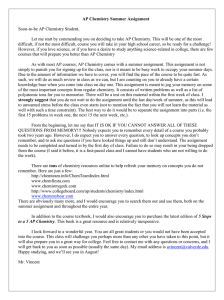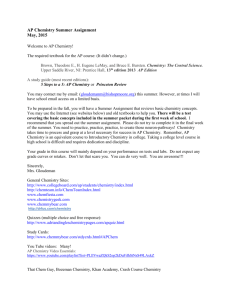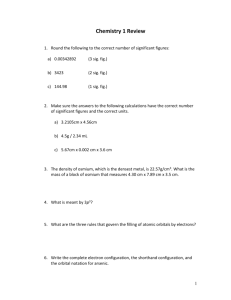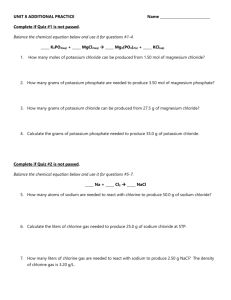You should pace yourself during the summer for this assignment
advertisement
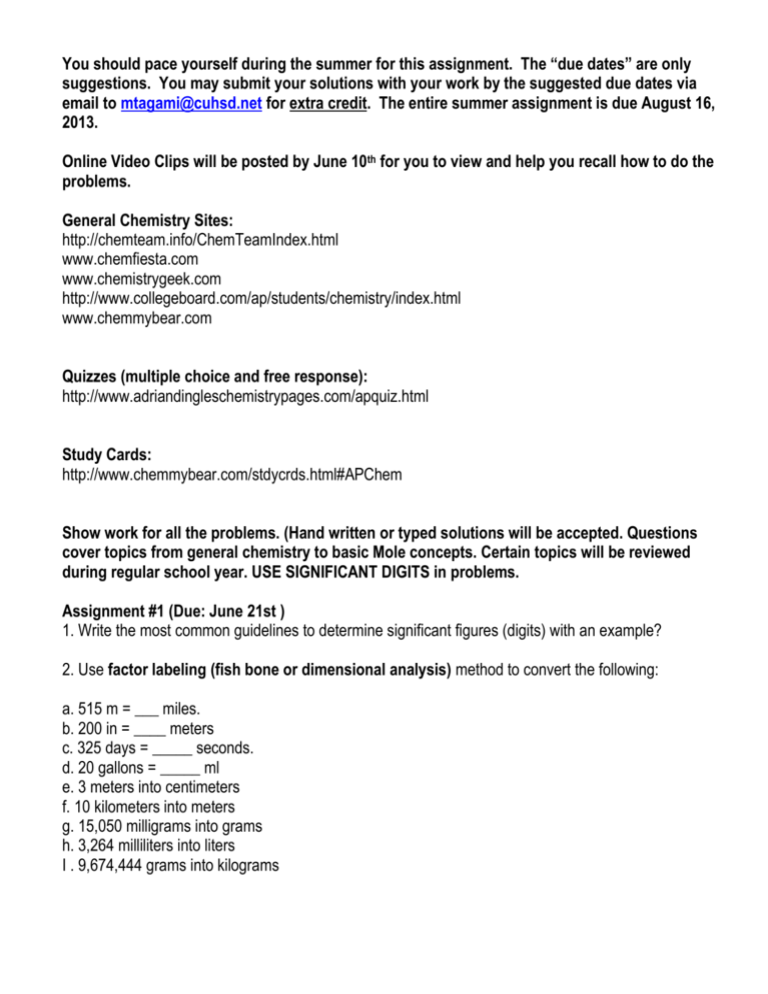
You should pace yourself during the summer for this assignment. The “due dates” are only suggestions. You may submit your solutions with your work by the suggested due dates via email to mtagami@cuhsd.net for extra credit. The entire summer assignment is due August 16, 2013. Online Video Clips will be posted by June 10th for you to view and help you recall how to do the problems. General Chemistry Sites: http://chemteam.info/ChemTeamIndex.html www.chemfiesta.com www.chemistrygeek.com http://www.collegeboard.com/ap/students/chemistry/index.html www.chemmybear.com Quizzes (multiple choice and free response): http://www.adriandingleschemistrypages.com/apquiz.html Study Cards: http://www.chemmybear.com/stdycrds.html#APChem Show work for all the problems. (Hand written or typed solutions will be accepted. Questions cover topics from general chemistry to basic Mole concepts. Certain topics will be reviewed during regular school year. USE SIGNIFICANT DIGITS in problems. Assignment #1 (Due: June 21st ) 1. Write the most common guidelines to determine significant figures (digits) with an example? 2. Use factor labeling (fish bone or dimensional analysis) method to convert the following: a. 515 m = ___ miles. b. 200 in = ____ meters c. 325 days = _____ seconds. d. 20 gallons = _____ ml e. 3 meters into centimeters f. 10 kilometers into meters g. 15,050 milligrams into grams h. 3,264 milliliters into liters I . 9,674,444 grams into kilograms 3. Classify each of the following as units of mass, volume, length, density, energy, or pressure. a. mg b. mL c. cm3 d. mm e. kg/m3 f. kJ g. atm h. cal. 4. Most laboratory experiments are performed at room temperature at 25˚C. Express this temperature in: a. ˚F b. K 5. A cylinder rod formed from silicon is 16.8 cm long and has a mass of 2.17 kg. The density of silicon is 2.33 g/cm3. What is the diameter of the cylinder? (the volume of cylinder is given by Π r2h, where r is the radius and h is the length) 6. How many significant figures are in each of the following? a. 1.92 mm b. 0.030100 kJ c. 6.022 x1023 atoms d. 460.00 L e. 0.00036 cm3 f. 100 g. 1001 h. 0.001 i. 0.0101 7. Record the following in correct scientific notation: a. 350,000,000 cal b. 0.0000721 mol c. 0.0000000809 Ǻ d. 765,400,000,000 atoms 8. Calculate the following to the correct number of significant figures. a. 1.27 g / 5.296 cm3 b. 12.235 g / 1.01 L c. 12.2 g + 0.38 g d. 17.3 g + 2.785 g e. 2.1 x 3.21 f. 200.1 x 120 g. 17.6 + 2.838 + 2.3 + 110.77 9. Give the chemical symbols for the following elements: a. Carbon b. sulfur c. Titanium d. Nitrogen e. Helium 10. Write the Latin and Common names for each of the elements symbols: a. Na b. Au c. Ag d. Sn e. Fe f. Hg g. K 11. A solid white substance A is heated strongly in the absence of air. It decomposes to form a new white substance B and a gas C. The gas has exactly the same properties as the product obtained when carbon is burned in an excess of oxygen. Based on these observations, can we determine whether solids A and B and the gas C are elements or compounds? Explain your conclusions for each substance. 12. Label each of the following as either a physical process or a chemical process. a. Corrosion of aluminum metal. b. Melting of ice. c. Pulverizing an aspirin. d. Digesting a candy bar. e. Explosion of nitroglycerin. f. Milk turning sour. g. Burning of paper. h. Forming of frost on a cold night. i. Bleaching of hair with hydrogen peroxide. j. A copper wire is hammered flat. Assignment #2 (Due: July 12th) 13. Calculate the mass of O2 produced if 2.50 g KClO3 are completely decomposed by heating. 14. Write the formula of the following compounds? (Use criss- cross method) a. Calcium sulfate. b. Ammonium Phosphate c. Lithium Nitrite d. potassium perchlorate. e. Barium Oxide f. Zinc sulfide. 15. Convert 3.57 atm to: (Using factor-labeling method) a. mm Hg b. pascals . 16. Define the words: atomic number, atomic mass, mass number, molecular formula, structural formula, empirical formula, isotopes, cation, anion, metalloid, allotrope, stoichiometry. 17. Determine number of protons and neutrons in each of the following. a. K1939 b. 2311Na. c. 20882Pb d. 3315P 18. White gold is an alloy that typically contains 60.0% by mass gold and the remainder is platinum. If 175 g of gold are available, how many grams of platinum are required to combine with the gold to form this alloy? 19. What is the empirical formula of a compound that contains 53.73% Fe and 46.27% of S ? 20. Determine the number of molecules in 2.23 mol of nitrogen (N2) molecules. 21. List the following has diatomic molecule, Molecular compound, Ionic compound, Atomic element. a. F2 b. Cl2 c. C d. NaCl e. KF f. CO2 g. H2 h. Ag i. Rust (Fe2O3) j. MgO k. O2 l. I2 22. State the contribution of the following chemist in one line. a. Democritus b. Mendeleev c. Henry Becquerel d. Roentgen e. J.J Thompson f.Faraday g. Chadwick h. Millikan i. Proust j. Cavendish k. Madam Curie 23. What is the difference between a. Chlorine atom and Chloride ion? b. Sodium atom and sodium ion. 24. How many grams of nitrogen are present in 2.3 moles of nitrogen gas? 25. Calculate the mass in grams of each of the following: a. 6.02 x 1023 atoms of Mg. b. 3.01 x 1023 Formula units of CaCl2. 26. In an experiment, a student gently heated a hydrated copper compound to remove the water of hydration. The following data was recorded: 1. Mass of crucible, cover, and contents before heating 23.54 g. 2. mass of empty crucible and cover 18.82 g. 3. mass of crucible, cover, and contents after heating to constant mass 20.94 g. 4. Calculate the experimental percent of water in the compound. 27. How do you distinguish: a. An element from a compound. b. An element from a mixture. c. A true solution from a heterogeneous mixture. d. Distillation from filtration. 28. An extensive property is one that depends on the amount of the sample. Which of the following Properties are extensive? a. volume b. density c. temperature d. energy e. melting point. 29. A hydrated compound has an analysis of 18.29% Ca, 32.37% Cl, and 49.34% water. What is its formula? 30. Name the types of general inorganic reactions with example of each. 31. Define Acid, base and salt? Give some examples of each. 32. What is the difference between the Bronsted-Lowry, Lewis and Arrhenius definition of a base? An Acid? Assignment #3 (Due: July 26th) 33. What mass of copper is required to replace silver from 4.00g of silver nitrate dissolved in water? Cu(s) + AgNO3 → Cu(NO3)2 + Ag. 34. Write the chemical formulas for the following compounds: a. Calcium Carbonate b. Ammonium Phosphate c. Sodium Chloride d. Sodium Oxide e. Calcium Sulfate f. Sodium Nitrite g. Magnesium Acetate h. Potassium cyanide i. Zinc (II) Nitrate j. Iron (III) Phosphate k. Nickel (II) Fluoride 35. Define a. Law of conservation of mass. b. Law of multiple proportion. 36. An isotope of Iodine used in thyroid disorders is 13153I how many a. Protons are in its nucleus? b. Neutrons are in its nucleus? c. Electrons are in an Iodine atom? d. Neutrons and protons are in the I-1 formed from this isotope? 37. Strontium consists of four isotopes with masses and their percent abundance of 83.9134 amu ( 0.5%), 85.9094 amu (9.9%) , 86.9089 amu (7.0 %) , and 87.9056 amu (82.6 %). Calculate the atomic mass of Sr ? 38. Nitrogen has two isotopes, N-14 and N-15, with atomic masses of 14.00031 amu and 15.001 amu, respectively. What is the percent abundance of N-15? 39. Write the number of protons and electrons? a P4 molecule b. a PCl5 molecule c. a P3- Ion d. P 5+ ion. 40. Mercury has an atomic mass of 200.59 amu. Calculate the a. Mass of 3.0 x 1010 atoms. b. Number of atoms in one nanogram of Mercury. 41. Calculate the molar masses ( g/ mol) of a. Ammonia ( NH3) b. Baking soda ( NaHCO3)) c. Osmium Metal (Os) 42. Convert the following to moles a. 3.86 grams of Carbon dioxide. b. 6.0 x 10 5g of Hydrazine (N2 H4), a rocket propellant. 43. The molecular formula of morphine, a pain-killing narcotic, is C17H19NO3. a. What is the molar mass? b. What fraction of atoms in morphine is accounted for by carbon? c. Which element contributes least to the molar mass? 44. Complete the list ionic compounds ( name or formula) a. Cupric Hydroxide b. Strontium Chromate c. Ammonium Per chlorate d. NaHCO3 e. Fe2 (CO3)3 f. Sodium Hydroxide. g. Potassium Chloride. 45. Determine the formula mass for the following: a. N2O5 b. CuSO4 C. Ca(HCO3)2 d. CaSO4. 2 H2O 46. Calculate the percentage by mass of the following compounds: a. SO3 b. CH3COOCH3 c. Ammonium Nitrate. 47. Determine the empirical formula of the compounds with the following compositions by mass: a. 10. 4 % C, 27. 8% S , 61. 7 % Cl b. 21.7 % C, 9.6 % O, and 68.7 % F 48. Arsenic reacts with chlorine to form a chloride. If 1.587 g of arsenic reacts with 3.755 g of chlorine, what is the simplest formula of the chloride? 49. Vanillin, a flavoring agent, is made up of carbon, hydrogen, and Oxygen atoms. When a sample of Vanillin weighing 2.500g burns in Oxygen, 5.79 g of carbon dioxide and 1.18 g of water are obtained. What is the empirical formula of Vanillin? 50. Washing soda is a hydrate of sodium carbonate. Its formula is Na2CO3. x H2O. A 2.714 g Sample of washing soda is heated until a constant mass of 1.006 g of Na2CO3 is reached. What is x ? 51. What is the molecular formula of each of the following compounds? a. empirical formula CH2 , molar mass =84g/mol. b. Empirical formula NH2Cl, Molar mass = 51.5 g/ Mol Assignment #4 (Due: August 12th ) 52. Determine the empirical and molecular formula of each of the following substances: a. Ibuprophen, a headache remedy contains 75.6 % C, 8.80 % H , and 15.5 % O by mass and has a molar mass about 206 g/mol. b. Epinerphine( adrenaline) a hormone secreted into the bloodstream in times of danger or stress contains 59% C, 7.1% H, 26.2% O, and 7.7% N by mass, its MW is about 180 amu. 53. Write balanced chemical equations for the reactions of sodium with the following nonmetals to form ionic solids. a. Nitrogen b. Oxygen c. Sulfur d. Bromine 54. Write a balanced equation for the following: a. Reaction of boron trifluoride gas with water to give liquid hydrogen fluoride and solid boric acid, (H3BO3). b. Reaction of magnesium Oxide with Iron to form Iron (III) Oxide and Magnesium. c. The decomposition of dinitrogen Oxide gas to its elements. d. The reaction of Calcium Carbide solid with water to form calcium hydroxide and acetylene (C2H2) gas. e. The reaction of solid calcium cyan amide (CaCN2) with water to from calcium carbonate and ammonia gas. f. Ethane burns in air (Oxygen). g. Hydrogen reacts with oxygen to from Water. h. Nitrogen gas reacts with Hydrogen to form Ammonia. i. Hydrogen reacts with Iodine gas to form Hydrogen Iodide. j. Sodium reacts with Iodine gas to form Sodium Iodide. k. Sodium Oxide reacts with water to form sodium hydroxide and hydrogen. l. Carbon dioxide combines with water to form carbonic acid. m. Magnesium and nitrogen gas combine to form magnesium nitride. n. Conc. Hydrochloric acid reacts with Conc. Sodium hydroxide to form sodium chloride and water. 55. Define limiting reagent, theoretical yield, and actual yield. 56. Define the following terms: a. Electrochemistry b. Electrolysis c. Voltaic Cell 57. Name the five different types of chemical reaction and their general formulas. 58. Define solubility. Prepare a list of solubility rules for ionic compounds in water. ( online resources) ( IMPORTANT) 59. Name the following: a. CO2 b. P4S10 c. NI3 d. PCl5 e. CCl4 f. SF6 g. CH4 h. C2H6 i. C3H8 7 61. Which of the following statements are always true? Never true? Not always true? a. A compound wit the molecular formula C6H6 has the same simplest formula. b. The mass percent of copper in CuO is less than in Cu2O. c. The limiting reactant is the one present in the smallest number of grams. d. Since C3H6O3 and C6H12O6 reduce to the same formula, they represent the same compound. 62. Define strong electrolyte, weak electrolyte, precipitation reactions and solubility? 63. What is an Activity series of metal? How does it help us in studying properties of elements? (Research on the internet!) 64. A volatile liquid (one that evaporates) is put into a jar and the Jar is then sealed. Does the mass of the sealed jar and its contents change upon the vaporization of the liquid? 65. Identify each of the following as being most like an observation, a law, or a theory. a. All coastal areas experience two high tides and two low tides each day. b. The tides in Earth’s oceans are caused mainly by the gravitational attraction of the moon. c. Yesterday, high tide in San Francisco Bay occurred at 2.43 a.m. and 3.07 P.m. d. Tides are higher at the full moon and ne moon than at other times of the month. 66. Define the terms: Exothermic, endothermic reactions? How much heat is required to raise the temperature of 100 grams of water from 250C to 820C? 67. A piece of unknown metal with mass 14.9 g is heated to 1000C and dropped into 75.0 g of water at 200C. The final temperature of the system is 28 degree Celsius. What is the specific heat of the metal? 68. What is a solute and solvent? Define Molarity, Molality, mole-fraction and Mass percent of a solution? 69. Calculate the molarity of a solution that contains 20.0grams of sodium hydroxide in 200ml? 70. How many grams of solute are present in 50.0 ml of 0.360 M sodium chloride?
